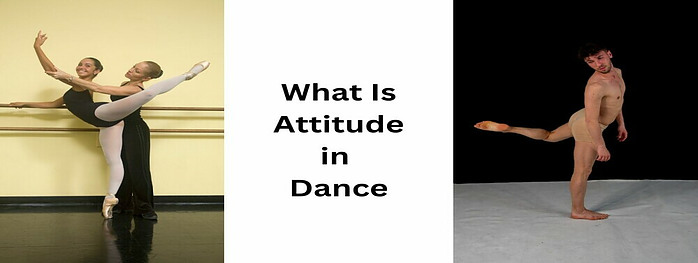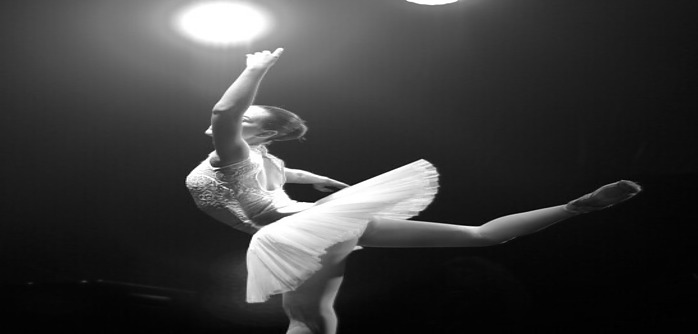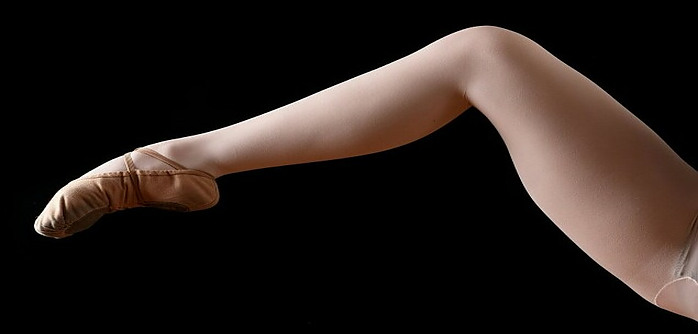What is attitude in dance? Apart from the attitude a dancer is giving you, I am actually referring to the attitude step.
Attitudes are derived from ballet, but other dance forms like jazz and contemporary also use the attitude leg a lot.
 What Is An Attitude?
What Is An Attitude?
Here is an explanation of the attitude in dance, which could be taken to the back (derriere) like the pictures above, the front (devant), and the side (second).
- The hip of the gesture leg is at 90 degrees to the leg with the knee bent and the foot pointed.
- The leg is lifted to the front, the side, or the back.
- The idea is that the knee will always be higher than the toe, especially when the leg is at the back. This is what makes this so difficult, but the dancer must be aware of working her turnout from the hip joint.
- Tremendous work is done through the adductors to sustain the movement. The turnout muscles are held firmly and the hips should remain in alignment.
- It is important for a dancer not to over or under bend the leg in attitude causing the lifted and bent leg to look either too short or too long. If it is too long it could be mistaken for a bad arabesque.
The difficult thing about the attitude position is the ability to identify turnout, flexibility, and strength without using the spine.
Forward Attitude or Attitude Devant
You need to have flexibility in your hamstring, glutes, and hips.
To have that gorgeous line, your glutes have to be flexible enough to release so the hip can rotate the femur head back.
With that being said, your hamstring can’t get in the way.
Your hips also have to have the flexibility to let this process happen without any shift in the hips or the core. This means no lateral shifting or tipping.
A student has to have a strong understanding and grasp of their turnout.
If a student doesn’t know how to rotate the hip outwards or laterally, they will struggle with the concept of rotating the leg up, and instead, they grip in the quad and lift. Then with the quad gripped, the leg can only rotate so much and only gain a certain amount of height.
Students need a very strong and connected core to have a good attitude in dance.
If you don’t have a connected core, your hips and back can easily become displaced and the dancers will develop poor alignment habits.
The ideal line of the attitude front should be that the heel and the knee should be in a line. If your body can’t achieve the ideal, then it should be a higher knee than heel with the most rotation possible. The line of the attitude devant is difficult because of the turnout factor.
A lot of dancing schools teach the attitude front from the Sur le coup de pied position, which is the ideal position of attitude, but the leg rotated to 90 degrees.
The idea is to rotate the heel forward so much, that the leg has to lift. Without changing the length of the leg or the degree of the bend in the knee, you rotate upwards and achieve the line.
This creates a very long attitude, and the line goes slightly down from the knee.
Things to avoid when moving forward is the gripping of the quad. When the quad grips instead of lengthening or rotating, it causes a lot of tension at the hip flexor and the hip joint, which unfortunately doesn’t allow the position to grow.
As the dancer brings the leg up. Avoid hips shifting and avoid turning in the supporting leg.
To improve your attitude devant, you can do your pigeon stretch for 15 minutes a day on each side. It takes a lot of stretching of the glutes and constant core work.
See this article on opening out those hips.
Back Attitude or Attitude Derriere
The back attitude is dependent on how the lines curve and intersect, how your center is placed and weighted, and the tipping of your pelvic cradle.
Ideally, both the standing and the working leg are turned out, but the working leg (the one in attitude) will shift within the hip joint.
The femur head roles forward towards the front flipping the passe horizontally and back.
Ideally, there is no tipping in the pelvis, and tension is created ‘by the working knee pressing up, while the lover leg’s turnout rotates downward.

The lower portion of the leg is slightly opened to give a curved spiraling line.
The height of the attitude comes from how far you can rotate the femur head forward to achieve the line. As the femur head rocks forward, the passe then flips and shifts directed by the knee and supported by the sartorius, moves behind the spinal cord.
The foot gradually opens from the passe position into the coupe position and length.
The sure le coup de pied is basically the shape and length of the correct position.
The position is extremely hard on the back because ideally the same concept of letting the femoral head roll forward and outwardly rotating the femur behind you.
This creates a perfect perpendicular shape from the side but creates an elongated spiral through your back. If you are hypermobile, you can separate the hips easily from your spinal cord, but for most, this position has to be cheated with the tipping forward of the pelvic cradle.
Side Attitude
The side attitude is seen mostly in modern or contemporary dancing and is not used a lot in classical ballet. However, a dancer would pass through a side attitude when doing a developpe to seconde.
The leg will only be out to the side as far as the hips will allow without them pulling backwards, so the knee is often in front of the working shoulder.
Both hips need to remain level and square to the front at all times and the leg can be lengthened beyond a 90-degree bend to give a better line.
I hope this article has explained attitude in dance and you understand a little better what is expected of your body.

